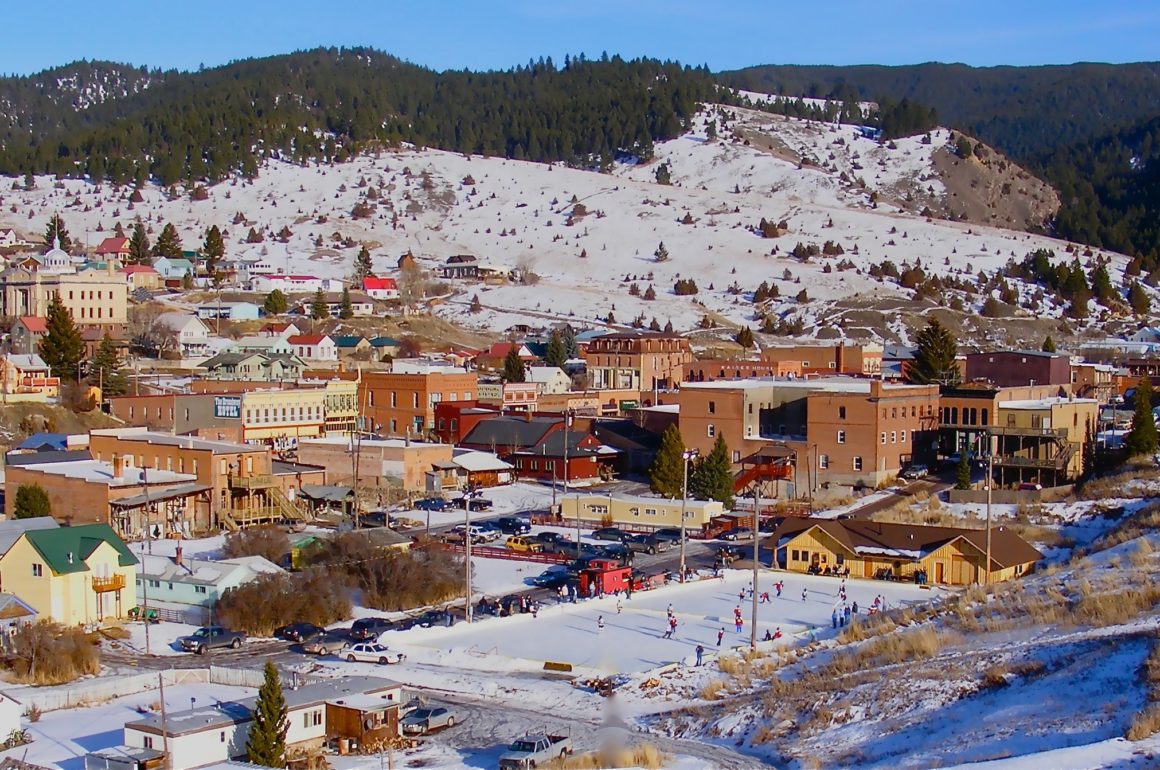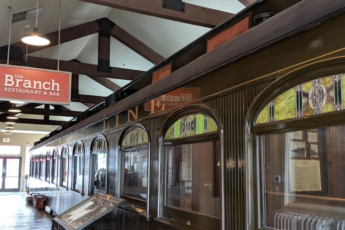
Philipsburg and its Ice Rink. Photo courtesy of Jim Jenner
The Town Makes Its Own Boom, but Housing May Be Its Bust
Don Bowen’s great grandfather moved from Wales to Philipsburg in 1882, only fifteen years after the town was formed. Don’s great-grandfather built many of the historic buildings preserved in Philipsburg’s historic district today.
Don used to say he was related to half the town. When his son married, all of Broadway street was shut down for the wedding. No building would have been large enough for the wedding because the whole town was coming. Because the whole town was coming, there was no need for the main street to be open. Now, Don jokes that he is related to half the cemetery.
Philipsburg boomed in the late 1800s and early 1900s because of silver mining. During World War I, Philipsburg experienced a boom because it was the largest domestic supplier of manganese.
“After that boom, Philipsburg has slipped into a stable existence based on agriculture, government, logging, limited mining and tourism,” reads the historic building plaque posted on the side of town hall.
By the 1990s, the bank owned many of the historic buildings on Broadway, the main street. Granite County homes dozens of ghost towns that folded up on themselves when mining and logging stopped providing the economic stimulus the county once enjoyed.
Philipsburg felt the pinch. Shirley Beck, co-owner of Sapphire Gallery and The Sweet Palace, remembers walking downtown in November, 1979 soon after moving to Philipsburg. Most businesses were closed and many buildings sported painted-over windows. Yet Shirley said she thought at the time: “Look at this town. Look at these buildings. It’s fabulous.” After meeting Shirley, we concluded that she has a different but refreshing perception of opportunity than most.
Shirley worked at the Gem Mountain Sapphire Mine until 1991, when she lost her job. That’s when she teamed up with Dale Siegford, who had been digging up local sapphires for a couple of years on Gem Mountain in Philipsburg, experimented with a new heat treatment of sapphires that enhances their color. On a quest to revitalize main street, the two took the downtown by storm.
They started repainting and remodeling buildings with their own hands. Community diehards like Don joined them in rebooting Philipsburg. Then Shirley and Dale opened the Sapphire Gallery in 1992, followed by The Sweet Palace in 1998. Tourists love the candy shop — a must-stop shop that leads them to other amenities in town.
“I look back at it and I don’t know why I thought we could do this,” Shirley said about their business ventures. She humorously described herself and Dale as a ranch wife and a guy sporting a failed afro. Any person or business that had the capital to survive taking a big risk left town with mining and logging. Their departure left Philipsburg with an abandoned main street. However, it wasn’t any big company or large grant that saved Philipsburg. It was quirky, industrious ladies like Shirley who can talk anyone into a corner and guys like Dale who need a haircut.
Now, Shirley and Dale own nine buildings downtown. Stripping the old paint off the windows and applying a fresh coat has visually jump-started the town, and Philipsburg started to thrive again.
Heidi Beck-Hesser, Shirley’s daughter, works as the corresponding secretary for the Philipsburg Chamber of Commerce. Heidi explained that fifth-generation families continue to ranch in the area, but tourism has become a leading industry for the town. Several annual events, a new brewery, a well-known theater and other amenities attract beer aficionados, artists and skiers from around the country.
The brightly painted buildings are not the only draw for Philipsburg. The town has worked hard to complement its summer tourism with winter recreational opportunities. In 2003, the Rotary Club of Philipsburg decided its centennial rotary project would be a professional-hockey-sized rink located in the center of town in wide-sweeping Winninghoff Park, which sports grassy built-in tiers for lawn chairs during the summer.
In 2007, the rink officially opened, but organizers resist resting on their laurels. The town continually makes improvements to the Winninghoff Park facility, which boasts enough outdoor seating for 3,000 visitors. The Philipsburg Ice Association was founded in 2013 to support the rink and recently raised funds to add a refrigeration unit for consistent ice use throughout the season, rather than relying on uncertain weather conditions.
“It took an unused space and made it more usable,” said Jim Jenner, Rotary Club member and independent filmmaker who was instrumental in the hockey rink development since the idea was conceived. The rink now pulls in families from all over the region during the winter months. After skating, families often visit the Sweet Palace or Gizmos, the toy store in town.
“We’re a blend of being a ski town and ice,” said Jim about the winter recreation economy.
Discovery Ski Area, half an hour from town, pulls in its fair share of not only tourists, but also regulars in the form of residents.
Rob Jarvis has been skiing Discovery since the early 1990s. He was a safety engineer for an aerospace company in Washington, but fell in love with the community in Philipsburg during his trips out to Montana to ski. Rob sums up his attraction to Philipsburg simply:
“Philipsburg is a town where kids and dogs can be kids and dogs.”
In 1992, he purchased the Sayrs Building, one of the historic buildings he first spotted when entering town. For years, he worked his day job in Washington state, but regularly visited Philipsburg for its old-time charm and skiing. But eight years ago he started talking with Cathy Smith and he learned that she, too, sought a lifestyle change.
Cathy moved from the Bitterroot to Philipsburg about 20 years ago. Nolan Smith, her husband, pulled her to the community. Eventually, in one act of rejuvenation, Cathy and Nolan, joined by head brewer Mike Elliott, teamed up with Rob in a shared vision to open Philipsburg Brewing Company.
The brewery opened in 2012 and now employs 15 people in the town of 900. Its proved to be a big success, thanks to word-of-mouth among beer-lovers, skiers and other tourists.
Cathy told us the main industry players in Philipsburg are nearby Rock Creek, a luxury guest ranch; the Granite Mountain Medical Center and the Pintler Ranger District Forest Service. Logging and ranching are not to be discredited either, although they play less of a role they once did for the town.
She believes the brewery is becoming a main employer in the area. However, like someone who genuinely loves her town, she is quick to mention the other downtown business and attractions, like the candy stor, gem gallery
For a small town tucked away in the scenic Philipsburg Valley Scenic Loop and located off major Montana interstate highways, P-Burg has been successful in creating its own community economy. Discovery Ski Hill sells the candy shop’s fudge and the brewery’s beer up for easy access after skiers come down off the mountain. Philipsburg’s iconic main street, Broadway, is as much a draw as is Discovery Ski Area. The hockey rink lures visitors during the winter, then converts to a grass dance floor in the summer when Winninghoff Park packs in lively concert-goers rather than hockey fans and ice-skaters.
For all the town’s growing success, remember that investors took a chance. Shirley and Dale took a risk in the early 1990s. They took out loans that Shirley jokingly says kept banker Jerry Sullivan from smiling for 90 days. However, that risk setoff a successful loop in Philipsburg in which each new business benefits and contributes to a palpable economic heartbeat in town. Every improvement, every added business, every good snow year, every hockey tournament and every annual concert boosts Philipsburg’s overall economy.
“It’s symbiotic and we’re glad to be a part of it,” Shirley told us.
However, revitalization has its growing pains, too. Heidi reminded us that Philipsburg is an old mining town not necessarily fit for modern-day living. There would need to be significant infrastructure improvements in the form of more houses and apartments added, along with expanded sewer and water systems, in order to update the town and accommodate the influx of employees.
Cathy explained to us that it is difficult to hire new employees at the brewery when there are no homes or apartments for them to rent. There is the possibility for new employees to commute from Anaconda or Drummond, but road conditions can be iffy during the winter. Additionally, the attraction of getting a job in Philipsburg is not simply paying work, but also the chance to live in the charming, friendly town.
Still, Philipsburg is in a pinch. With the economic growth has come steady population growth. Since 2012, the population has grown by 10 percent. Additionally, many homeowners realize they can capitalize on the tourism economy by listing their home as a VRBO (Vacation Rental By Owner), where they rent their homes out to vacationers for a couple of days at a time rather than rent on a long-term lease to a family. The combination of more residents and more tourists creates a bigger demand, creating a housing crisis.
Heidi explained that is doesn’t matter whether or not the town capitalizes on its recreational assets for employee recruitment. If there isn’t a house for a family to move into, no one cares if the ski hill is only 30 minutes away, she said.
“We could choke to death on tourism if we don’t look for a balanced approach to what that industry impacts,” said Jim Jenner. In addition to Jim’s involvement with rotary and the hockey rink, he recently finished a documentary, “Saving the Burg,” highlighting Philipsburg’s economic turn-around. It will air on Montana PBS in April. Watch for our Prairie Populist film review here soon.
Meanwhile, residents’ concerns about the
Philipsburg faces larger questions about its growth, but the community is hell-bent on improving itself. It’s important to note that Philipsburg differentiated itself from the other old mining towns that dried up by making itself a winter and summer destination. That strategy has worked well. Now weekenders take extra pains to visit P-Burg for its breweries, candy shop, restaurants, Opera House Theater and walkable small-town charm.
Don Bowen’s family has been in Philipsburg since 1882, only 15 years after Philipsburg became a town in 1867. Don represents the town’s changing economic drivers. He has worked a hodgepodge of jobs, including gas station manager, historic buildings renovator and Sweet Shop candyman for the last 20 years.
What is his all-time favorite job?
“Oh I’ve enjoyed ‘em all. Any time I can stay around here I enjoy them,” he said. His spirit embodies the refreshing new atmosphere that is P-Burg the destination.
-Andie Creel
Got something to say to Prairie Populist? Send news tips, story ideas and comments to [email protected]. If you have something to submit, or an idea for a story you’d like to write for us, check out our Submission Guidelines here.

